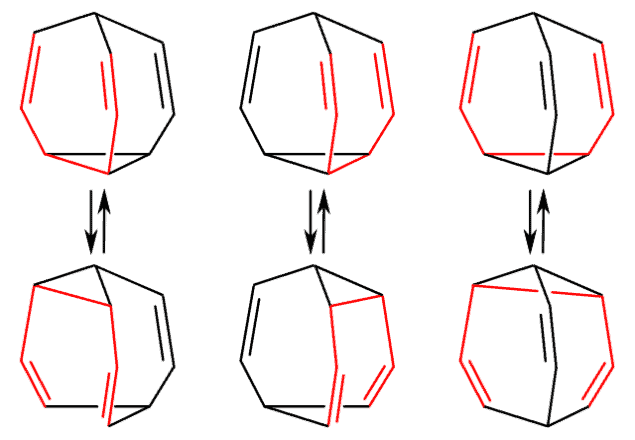
Researchers in Australia have detected and controlled changes to the shape of a single molecule in response to an applied mechanical force. The feat could enable the development of miniaturized implantable pressure sensors and accelerometers for the electronics industry.
The molecule in question, bullavene, is a hydrocarbon with the chemical formula C10H10. Importantly, it is piezoresistive, meaning that its electrical resistance changes in response to mechanical strain. In bullavene’s case, this strain occurs when the molecule changes between its different possible shapes, or isomers, altering the connectivity between its atoms and producing a measurable variation in its electrical resistance.
The researchers chose to explore piezoresistive behaviour in bullavene because it undergoes unusually large shape changes due to processes known as constitutional and conformational isomerism. “The former involves the rearrangement of bonding topologies while the latter involves molecules simply ‘flopping around’,” explains Jeffrey Reimers, a chemist at the University of Technology Sydney who led the study together with Nadim Darwish of Curtin University, Daniel Kosov of James Cook University and Thomas Fallon of the University of Newcastle.

To measure bullavene’s changing resistance, the team used chemical attachments called diaryls to bind the molecule to gold contacts 7 to 15 angstroms apart. When these gold contacts move, the molecule remains bound to them, but the mechanical strain it experiences causes it to form a new isomer with a different shape. This shape change modifies the flow of electricity through the molecule, and the researchers were able to measure these changes using scanning tunnelling microscopy.
Miniature sensors and millisecond timescales
Piezoresistors are already widely deployed in a range of applications, including vibration detectors in electronic devices, pedometers in smartphones, triggers for car airbags and implantable medical sensors. Because bullavene molecules are so small, they could be used to create miniaturized versions of these conventional devices. A bullavene-based sensor could also detect the presence of other chemicals or biomolecules such as proteins or enzymes – something that might be important for detecting diseases, Darwish says.

Wearable pressure sensors extend their range
The researchers, who detail their work in Nature Communications, say they can envisage creating devices as small as 3 to 100 nm2 that detect external forces and pressures simply by measuring changes in resistance. Another useful feature, Kosov adds, is that the piezoresistors can be made to oscillate at 800 Hz, which means they could be used to monitor processes that occurs on millisecond timescales.
The next stages in the team’s work will involve transferring the technology from an expensive microscopy experiment into a cheap sensing platform. “This will require us to develop nano-electrode sensors whose active elements are our shape-shifting molecules,” Darwish tells Physics World.
- SEO Powered Content & PR Distribution. Get Amplified Today.
- PlatoData.Network Vertical Generative Ai. Empower Yourself. Access Here.
- PlatoAiStream. Web3 Intelligence. Knowledge Amplified. Access Here.
- PlatoESG. Carbon, CleanTech, Energy, Environment, Solar, Waste Management. Access Here.
- PlatoHealth. Biotech and Clinical Trials Intelligence. Access Here.
- Source: https://physicsworld.com/a/single-molecule-makes-a-sensitive-pressure-and-force-sensor/
- :is
- 100
- 15%
- 160
- 7
- a
- Able
- active
- Adds
- already
- also
- an
- and
- Another
- apart
- applications
- applied
- ARE
- around
- AS
- At
- Australia
- BE
- because
- behaviour
- between
- bind
- Bound
- but
- by
- called
- CAN
- car
- case
- causes
- change
- Changes
- changing
- cheap
- chemical
- chose
- click
- Connectivity
- contacts
- controlled
- conventional
- could
- create
- Creating
- deployed
- detail
- detect
- detected
- develop
- Development
- Devices
- different
- diseases
- domain
- drawing
- due
- electricity
- Electronic
- Electronics
- elements
- enable
- expensive
- Experiences
- experiment
- Explains
- explore
- extend
- external
- feat
- Feature
- flow
- For
- Force
- Forces
- form
- Former
- formula
- from
- Gold
- Have
- http
- HTTPS
- image
- important
- importantly
- in
- Including
- industry
- information
- into
- involve
- issue
- IT
- ITS
- jpg
- known
- large
- Led
- made
- MAKES
- max-width
- meaning
- means
- measure
- measuring
- mechanical
- medical
- Microscopy
- might
- molecule
- Monitor
- move
- New
- next
- of
- on
- open
- or
- Other
- our
- Physics
- Physics World
- platform
- plato
- Plato Data Intelligence
- PlatoData
- possible
- presence
- pressure
- pressures
- processes
- producing
- Proteins
- question
- range
- rearrangements
- remains
- require
- researchers
- Resistance
- response
- say
- says
- scanning
- sensitive
- sensors
- Shape
- shapes
- simply
- single
- small
- smartphones
- So
- Soft
- something
- stages
- Study
- such
- SVG
- team
- Technology
- tells
- that
- The
- their
- Them
- These
- they
- this
- Through
- thumbnail
- to
- together
- Transferring
- true
- undergoes
- us
- used
- using
- versions
- were
- when
- which
- while
- WHO
- whose
- widely
- will
- with
- Work
- world
- zephyrnet













